2006 SUBARU TRIBECA power steering fluid
[x] Cancel search: power steering fluidPage 223 of 377
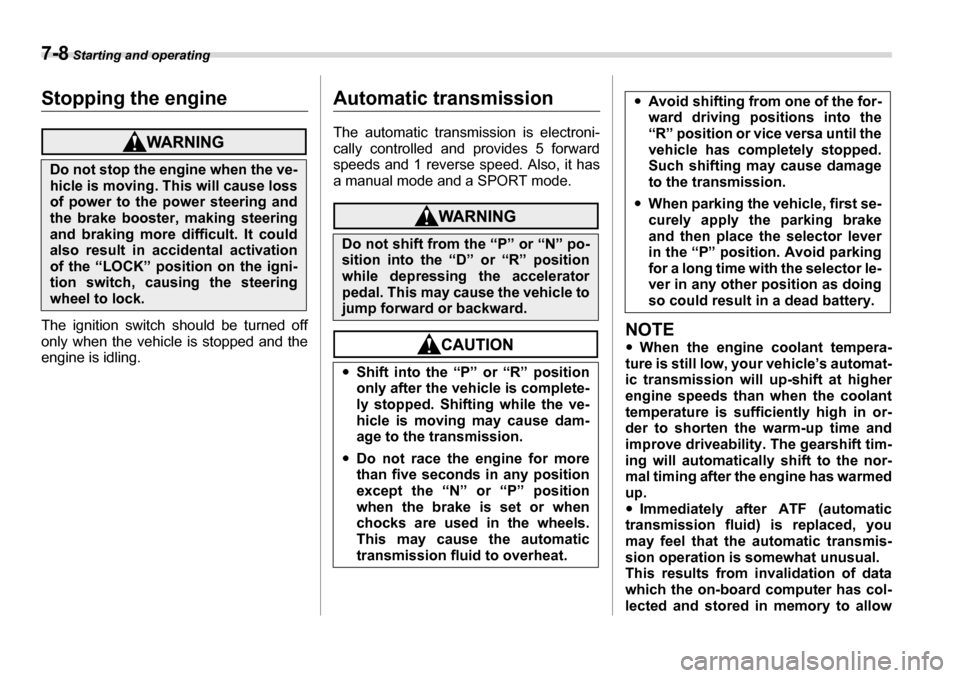
7-8 Starting and operating
Stopping the engine
The ignition switch should be turned off
only when the vehicle is stopped and the
engine is idling.
Automatic transmission
The automatic transmission is electroni-
cally controlled and provides 5 forward
speeds and 1 reverse speed. Also, it has
a manual mode and a SPORT mode.
NOTE �yWhen the engine coolant tempera-
ture is still low, your vehicle’s automat-
ic transmission will up-shift at higher
engine speeds than when the coolant
temperature is sufficiently high in or-
der to shorten the warm-up time and
improve driveability. The gearshift tim-
ing will automatically shift to the nor-
mal timing after the engine has warmed
up.�y Immediately after ATF (automatic
transmission fluid) is replaced, you
may feel that the automatic transmis-
sion operation is somewhat unusual.
This results from invalidation of data
which the on-board computer has col-
lected and stored in memory to allow
Do not stop the engine when the ve-
hicle is moving. This will cause loss
of power to the power steering and
the brake booster, making steering
and braking more difficult. It could
also result in accidental activation
of the “LOCK” position on the igni-
tion switch, causing the steering
wheel to lock.
Do not shift from the “P” or “N” po-
sition into the “D” or “R” position
while depressing the accelerator
pedal. This may cause the vehicle to
jump forward or backward. �y Shift into the “P” or “R” position
only after the vehicle is complete-
ly stopped. Shifting while the ve-
hicle is moving may cause dam-
age to the transmission.
�y Do not race the engine for more
than five seconds in any position
except the “N” or “P” position
when the brake is set or when
chocks are used in the wheels.
This may cause the automatic
transmission fluid to overheat.
�yAvoid shifting from one of the for-
ward driving positions into the
“R” position or vice versa until the
vehicle has completely stopped.
Such shifting may cause damage
to the transmission.
�y When parking the vehicle, first se-
curely apply the parking brake
and then place the selector lever
in the “P” position. Avoid parking
for a long time with the selector le-
ver in any other position as doing
so could result in a dead battery.
Page 230 of 377
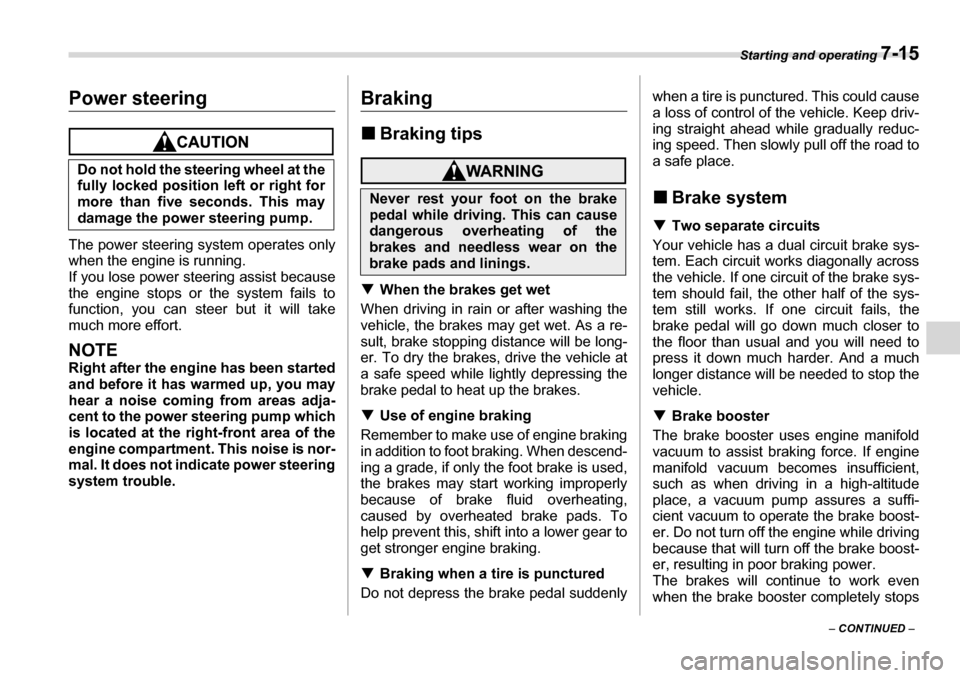
Starting and operating 7-15
– CONTINUED –
Power steering
The power steering system operates only
when the engine is running.
If you lose power steering assist because
the engine stops or the system fails to
function, you can steer but it will take
much more effort.
NOTE
Right after the engine has been started
and before it has warmed up, you may
hear a noise coming from areas adja-
cent to the power steering pump whichis located at the right-front area of the
engine compartment. This noise is nor-
mal. It does not indicate power steering
system trouble.
Braking �„Braking tips
�TWhen the brakes get wet
When driving in rain or after washing the
vehicle, the brakes may get wet. As a re-
sult, brake stopping distance will be long-
er. To dry the brakes, drive the vehicle at
a safe speed while lightly depressing the
brake pedal to heat up the brakes. �T Use of engine braking
Remember to make use of engine braking
in addition to foot braking. When descend-
ing a grade, if only the foot brake is used,
the brakes may start working improperly
because of brake fluid overheating,
caused by overheated brake pads. To
help prevent this, shift into a lower gear to
get stronger engine braking. �T Braking when a tire is punctured
Do not depress the brake pedal suddenly when a tire is punctured. This could cause
a loss of control of the vehicle. Keep driv-
ing straight ahead while gradually reduc-
ing speed. Then slowly pull off the road to
a safe place. �„
Brake system
�T Two separate circuits
Your vehicle has a dual circuit brake sys-
tem. Each circuit works diagonally across
the vehicle. If one circuit of the brake sys-
tem should fail, the other half of the sys-
tem still works. If one circuit fails, the
brake pedal will go down much closer to
the floor than usual and you will need to
press it down much harder. And a much
longer distance will be needed to stop the vehicle. �T Brake booster
The brake booster uses engine manifold
vacuum to assist braking force. If engine
manifold vacuum becomes insufficient,
such as when driving in a high-altitude
place, a vacuum pump assures a suffi-
cient vacuum to operate the brake boost-
er. Do not turn off the engine while driving
because that will turn off the brake boost-
er, resulting in poor braking power.
The brakes will continue to work even
when the brake booster completely stops
Do not hold the steering wheel at the
fully locked position left or right for
more than five seconds. This may
damage the power steering pump.
Never rest your foot on the brake
pedal while driving. This can cause
dangerous overheating of the
brakes and needless wear on the
brake pads and linings.
Page 298 of 377

11
Maintenance and service
Maintenance schedule ....................................... 11-3
Maintenance precautions .................................. 11-3 Before checking or servicing in the engine compartment ........................................................ 11-4
When you do checking or servicing in the
engine compartment while the engine is
running .................................................................. 11-4
Engine hood ....................................................... 11-4
Engine compartment overview ......................... 11-6
Engine oil ............................................................ 11-7 Checking the oil level ............................................. 11-7
Changing the oil and oil filter ................................ 11-7
Recommended grade and viscosity ..................... 11-9
Recommended grade and viscosity under severe driving conditions .................................... 11-10
Cooling system .................................................. 11-10 Hose and connections ........................................... 11-11
Engine coolant ........................................................ 11-11
Air cleaner element ............................................ 11-13 Replacing the air cleaner element ......................... 11-13
Spark plugs ......................................................... 11-14 Recommended spark plugs ................................... 11-14
Drive belts ........................................................... 11-15
Automatic transmission fluid ............................ 11-15 Checking the fluid level ......................................... 11-15
Recommended fluid ............................................... 11-16
Front differential gear oil ................................... 11-16 Checking the oil level ............................................. 11-16 Recommended grade and viscosity ..................... 11-17
Rear differential gear oil .................................... 11-17 Checking the gear oil level .................................... 11-17
Recommended grade and viscosity ..................... 11-18
Power steering fluid ........................................... 11-19 Checking the fluid level .......................................... 11-19
Recommended fluid ............................................... 11-19
Brake fluid ........................................................... 11-20 Checking the fluid level .......................................... 11-20
Recommended brake fluid ..................................... 11-20
Brake booster ..................................................... 11-21
Brake pedal ......................................................... 11-21 Checking the brake pedal free play ...................... 11-21
Checking the brake pedal reserve distance ......... 11-21
Replacement of brake pad and lining ............... 11-22 Breaking-in of new brake pads and linings .......... 11-22
Parking brake stroke .......................................... 11-23
Tires and wheels ................................................ 11-23 Types of tires .......................................................... 11-23
Tire pressure monitoring system (TPMS) ............ 11-23
Tire inspection ........................................................ 11-25
Tire pressures and wear ........................................ 11-25
Wheel balance ......................................................... 11-27
Wear indicators ....................................................... 11-27
Tire rotation ............................................................. 11-28
Tire replacement ..................................................... 11-28
Wheel replacement ................................................. 11-29
Aluminum wheels ............................................... 11-29
Page 303 of 377
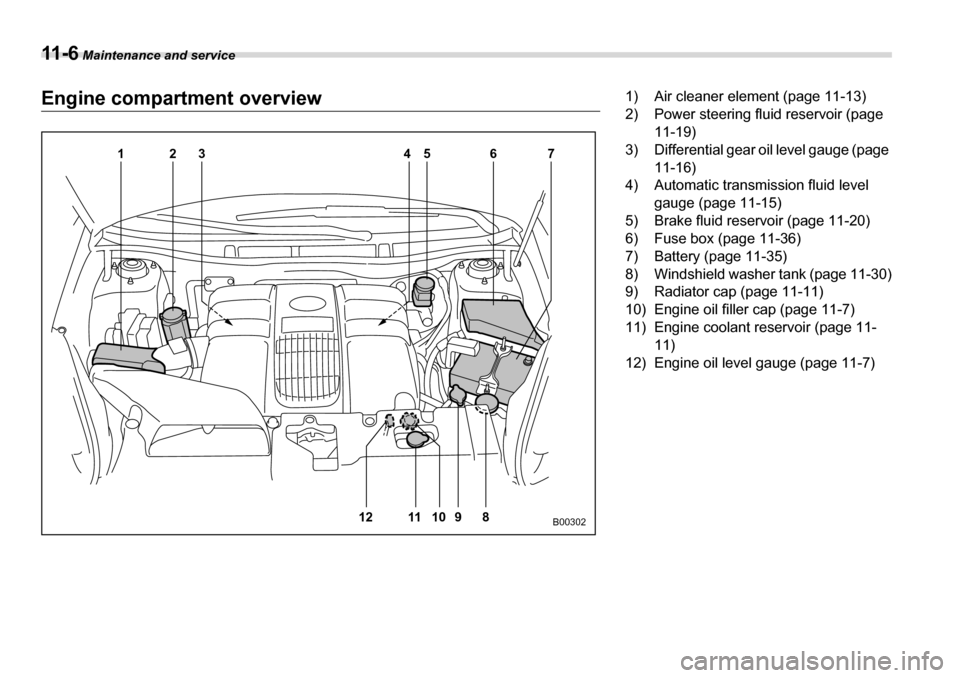
11 - 6 Maintenance and service
Engine compartment overview
123 4 5
11
12 10 9 8 67
B00302
1) Air cleaner element (page 11-13)
2) Power steering fluid reservoir (page
11-19)
3) Differential gear oil level gauge (page 11-16)
4) Automatic transmission fluid level
gauge (page 11-15)
5) Brake fluid reservoir (page 11-20)
6) Fuse box (page 11-36)
7) Battery (page 11-35)
8) Windshield washer tank (page 11-30)
9) Radiator cap (page 11-11)
10) Engine oil filler cap (page 11-7)
11) Engine coolant reservoir (page 11-
11)
12) Engine oil level gauge (page 11-7)
Page 312 of 377
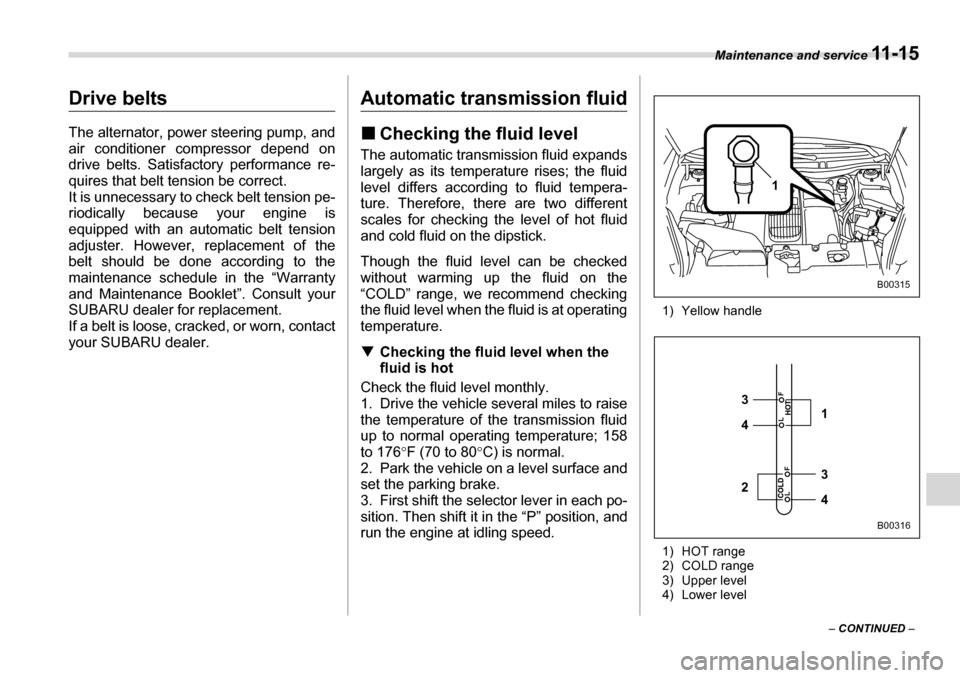
Maintenance and service 11 - 1 5
– CONTINUED –
Drive belts
The alternator, power steering pump, and
air conditioner compressor depend on
drive belts. Satisfactory performance re-
quires that belt tension be correct.
It is unnecessary to check belt tension pe-
riodically because your engine is
equipped with an automatic belt tension
adjuster. However, replacement of the
belt should be done according to the
maintenance schedule in the “Warranty
and Maintenance Booklet”. Consult your
SUBARU dealer for replacement.
If a belt is loose, cracked, or worn, contact
your SUBARU dealer.Automatic transmission fluid �„Checking the fluid level
The automatic transmission fluid expands
largely as its temperature rises; the fluid
level differs according to fluid tempera-
ture. Therefore, there are two different scales for checking the level of hot fluid
and cold fluid on the dipstick.
Though the fluid level can be checked
without warming up the fluid on the
“COLD” range, we recommend checking
the fluid level when the fluid is at operating
temperature. �T Checking the fluid level when the
fluid is hot
Check the fluid level monthly.
1. Drive the vehicle several miles to raise
the temperature of the transmission fluid
up to normal operating temperature; 158 to 176 °F (70 to 80 °C) is normal.
2. Park the vehicle on a level surface and
set the parking brake.
3. First shift the selector lever in each po-
sition. Then shift it in the “P” position, and
run the engine at idling speed. 1) Yellow handle
1) HOT range
2) COLD range
3) Upper level
4) Lower level
1
B00315
LF
LF
3 4
34 2
1
B00316
Page 316 of 377
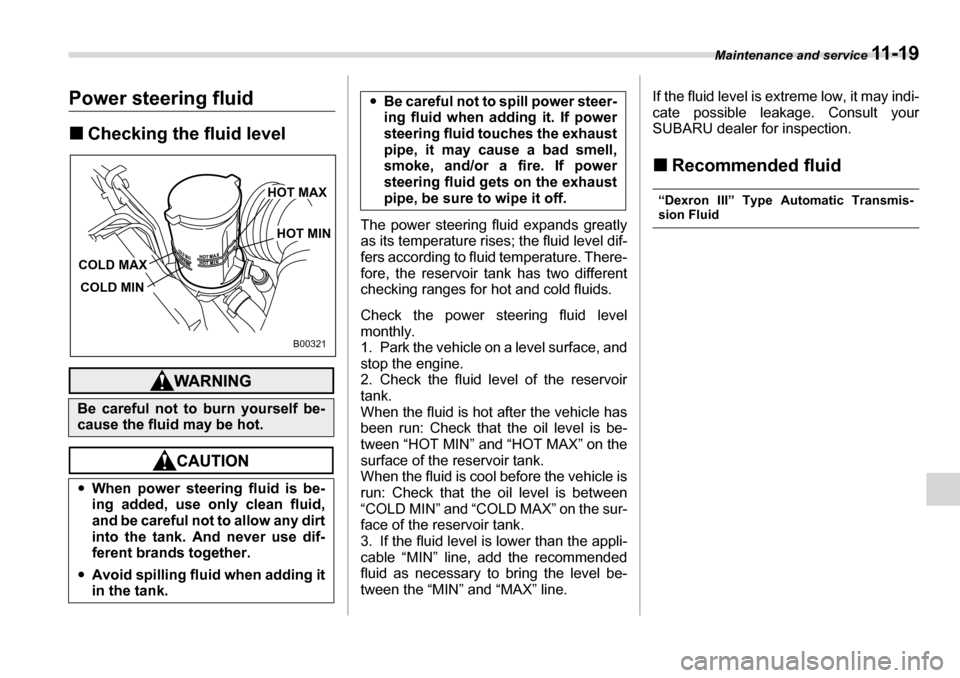
Maintenance and service 11 - 1 9
Power steering fluid �„Checking the fluid level
The power steering fluid expands greatly
as its temperature rises; the fluid level dif-
fers according to fluid temperature. There-
fore, the reservoir tank has two different
checking ranges for hot and cold fluids.
Check the power steering fluid level
monthly.
1. Park the vehicle on a level surface, and
stop the engine.
2. Check the fluid level of the reservoir
tank.
When the fluid is hot after the vehicle has
been run: Check that the oil level is be-
tween “HOT MIN” and “HOT MAX” on the
surface of the reservoir tank.
When the fluid is cool before the vehicle is
run: Check that the oil level is between
“COLD MIN” and “COLD MAX” on the sur-
face of the reservoir tank.
3. If the fluid level is lower than the appli-
cable “MIN” line, add the recommended
fluid as necessary to bring the level be-
tween the “MIN” and “MAX” line. If the fluid level is extreme low, it may indi-
cate possible leakage. Consult your
SUBARU dealer for inspection. �„
Recommended fluid
“Dexron III” Type Automatic Transmis-sion Fluid
Be careful not to burn yourself be-
cause the fluid may be hot. �yWhen power steering fluid is be-
ing added, use only clean fluid,
and be careful not to allow any dirt
into the tank. And never use dif-ferent brands together.
�y Avoid spilling fluid when adding it
in the tank.
HOT MAX
COLD MAX HOT MIN
COLD MIN
B00321
�y Be careful not to spill power steer-
ing fluid when adding it. If power
steering fluid touches the exhaust
pipe, it may cause a bad smell,
smoke, and/or a fire. If power
steering fluid gets on the exhaust
pipe, be sure to wipe it off.
Page 346 of 377
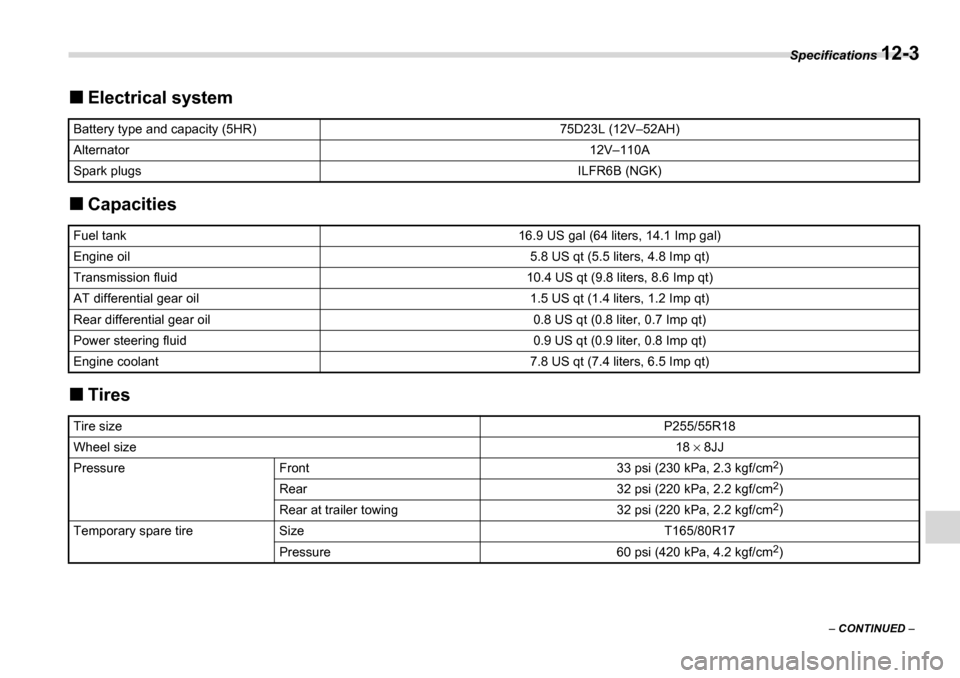
Specifications 12-3
– CONTINUED –
�„Electrical system
�„ Capacities
�„ Tires
Battery type and capacity (5HR)75D23L (12V–52AH)
Alternator12V–110A
Spark plugsILFR6B (NGK)
Fuel tank16.9 US gal (64 liters, 14.1 Imp gal)
Engine oil5.8 US qt (5.5 liters, 4.8 Imp qt)
Transmission fluid10.4 US qt (9.8 liters, 8.6 Imp qt)
AT differential gear oil1.5 US qt (1.4 liters, 1.2 Imp qt)
Rear differential gear oil0.8 US qt (0.8 liter, 0.7 Imp qt)
Power steering fluid0.9 US qt (0.9 liter, 0.8 Imp qt)
Engine coolant7.8 US qt (7.4 liters, 6.5 Imp qt)
Tire sizeP255/55R18
Wheel size18 × 8JJ
PressureFront33 psi (230 kPa, 2.3 kgf/cm 2
)
Rear32 psi (220 kPa, 2.2 kgf/cm 2
)
Rear at trailer towing32 psi (220 kPa, 2.2 kgf/cm 2
)
Temporary spare tireSizeT165/80R17
Pressure60 psi (420 kPa, 4.2 kgf/cm 2
)
Page 371 of 377
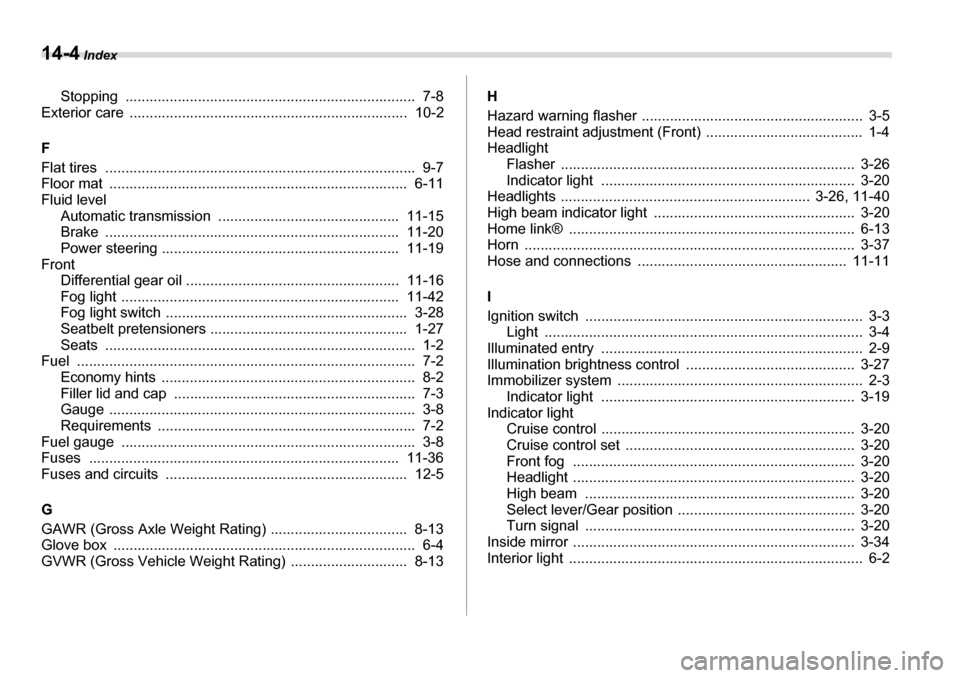
14-4 Index
Stopping ........................................................................ 7-8
Exterior care ..................................................................... 10-2 F
Flat tires ............................................................................. 9-7
Floor mat .......................................................................... 6-11 Fluid level
Automatic transmission ............................................. 11-15
Brake ......................................................................... 11-20
Power steering ........................................................... 11-19
Front Differential gear oil ..................................................... 11-16
Fog light ..................................................................... 11-42
Fog light switch ............................................................ 3-28
Seatbelt pretensioners ................................................. 1-27
Seats ............................................................................. 1-2
Fuel .................................................................................... 7-2
Economy hints ............................................................... 8-2
Filler lid and cap ............................................................ 7-3
Gauge ............................................................................ 3-8
Requirements ................................................................ 7-2
Fuel gauge ......................................................................... 3-8
Fuses ............................................................................. 11-36
Fuses and circuits ............................................................ 12-5 G
GAWR (Gross Axle Weight Rating) .................................. 8-13
Glove box ........................................................................... 6-4
GVWR (Gross Vehicle Weight Rating) ............................. 8-13 H
Hazard warning flasher ....................................................... 3-5
Head restraint adjustment (Front) ....................................... 1-4
Headlight
Flasher ......................................................................... 3-26
Indicator light ............................................................... 3-20
Headlights .............................................................. 3-26, 11-40
High beam indicator light .................................................. 3-20
Home link® ....................................................................... 6-13
Horn .................................................................................. 3-37
Hose and connections .................................................... 11-11 I
Ignition switch ..................................................................... 3-3 Light ............................................................................... 3-4
Illuminated entry ................................................................. 2-9
Illumination brightness control .......................................... 3-27
Immobilizer system ............................................................. 2-3 Indicator light ............................................................... 3-19
Indicator light Cruise control ............................................................... 3-20
Cruise control set ......................................................... 3-20
Front fog ...................................................................... 3-20
Headlight ...................................................................... 3-20
High beam ................................................................... 3-20
Select lever/Gear position ............................................ 3-20
Turn signal ................................................................... 3-20
Inside mirror ...................................................................... 3-34
Interior light ......................................................................... 6-2